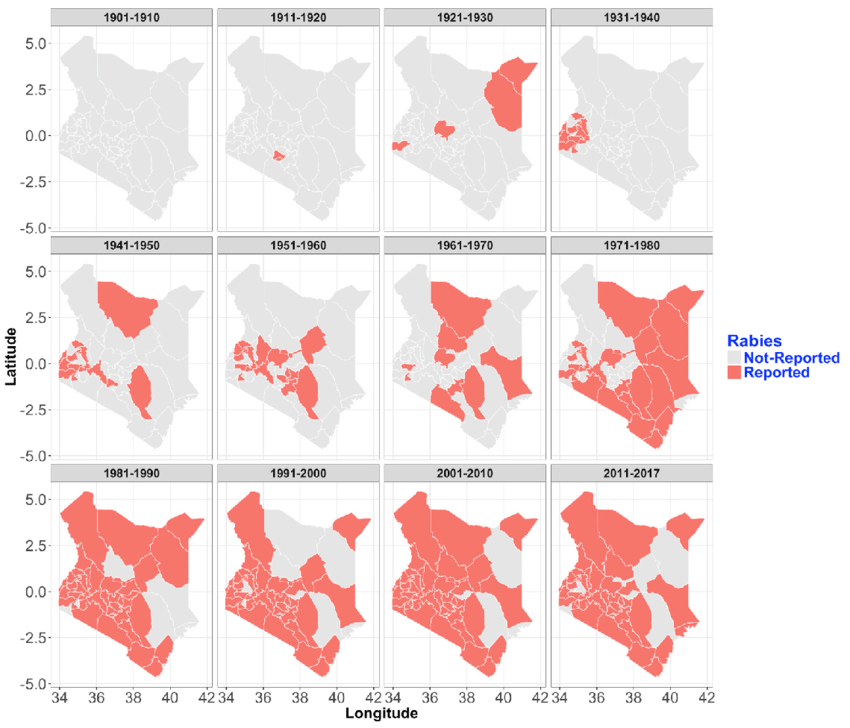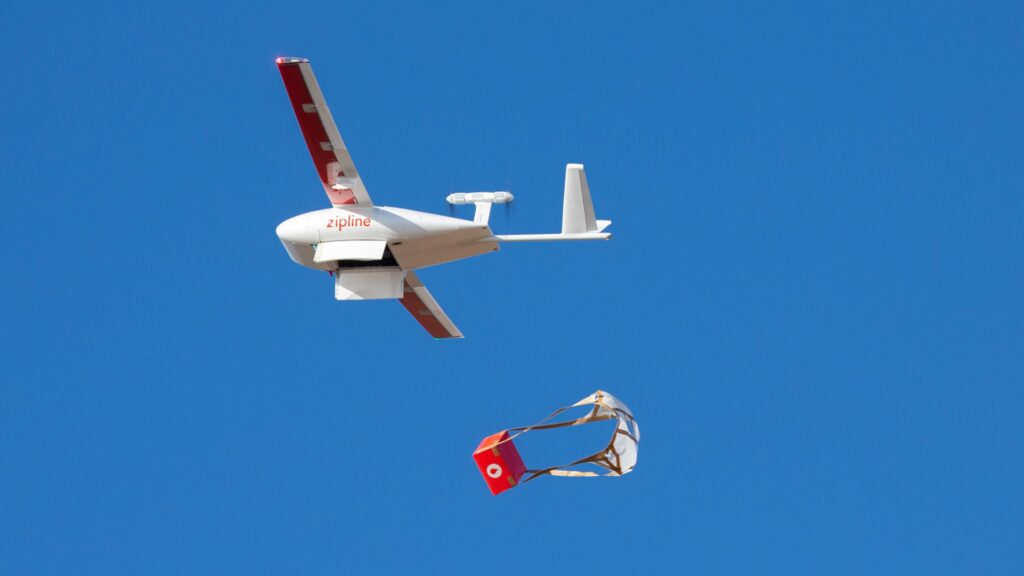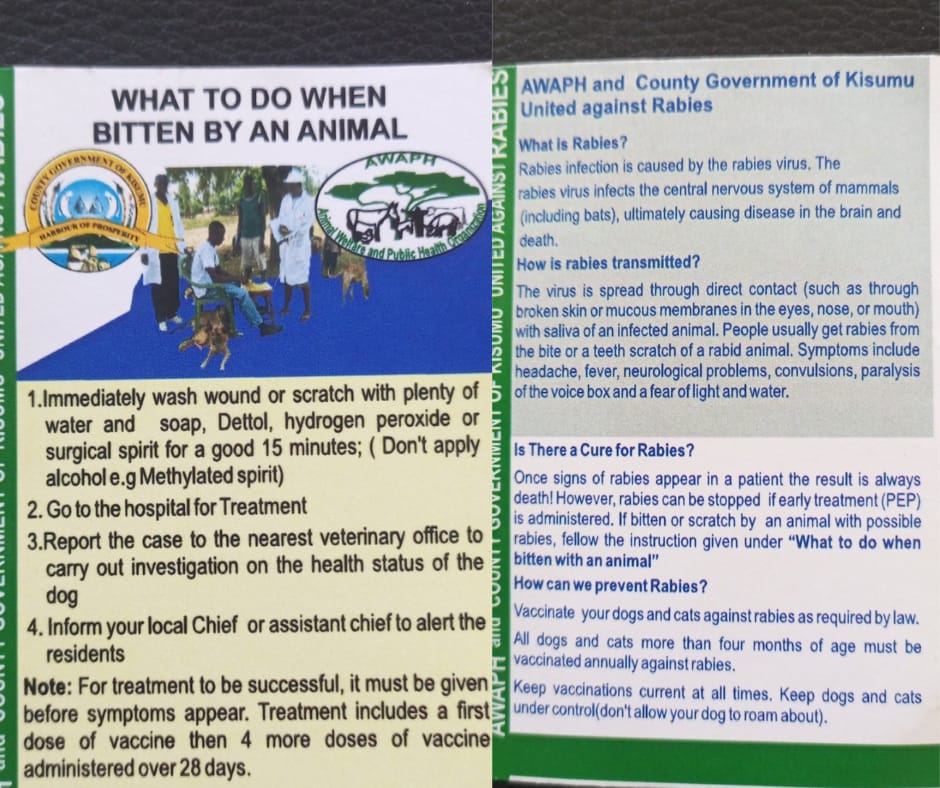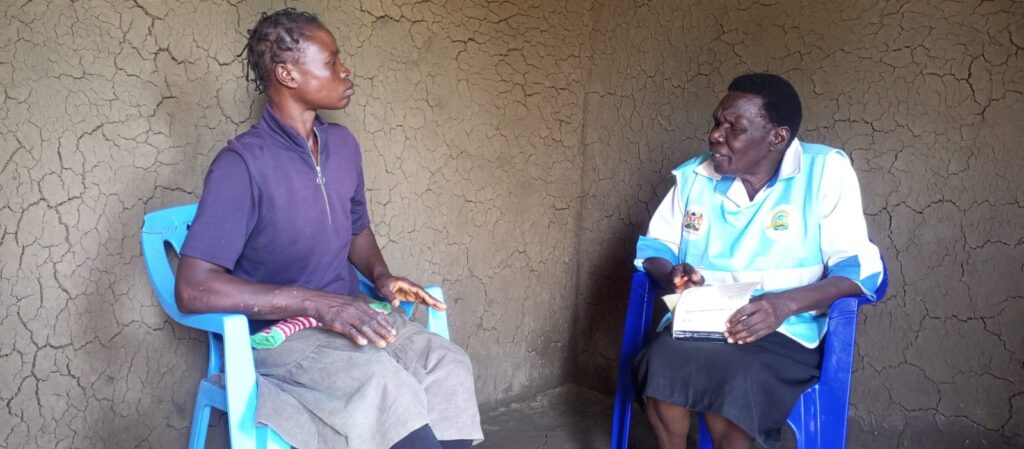“It was devastating!” This was Jackline Akinyi’s description of the loss of her daughter to rabies.
The daughter’s death in January 2019 formed part of the grim global statistics of rabies deaths, which shows that Africa continues to bear the biggest burden of the disease.
I was away when I got a call that a dog had attacked my daughter. I quickly returned home and rushed her to Gita Sub County Hospital,
Jackline Akinyi
The World Health Organization (WHO) estimates that globally, 59,000 people die from dog-mediated rabies annually.
WHO, in its report ‘The Road to 2030’ notes that over 95 percent of human deaths from rabies occur in Asia and Africa, adding that globally, the economic burden of dog-mediated rabies is estimated at US$ 8.6 billion per year.
Kenya’s Strategic Plan for the Elimination of Human Rabies in Kenya 2014 – 2030 shows that Kenya records approximately 2000 deaths associated with dog-mediated rabies annually.

A report on ‘Rapid epidemiological appraisal of spatial distribution of animal bite injury cases and rabies post-exposure prophylaxis in Kisumu County between 2018 and 2019 showed that there were 133 (63%) males and 78(37%) female cases of dog bites victims aged between was 11 and 40 years, with the cases being highest among 11 to 17 years age group.
The report further indicated that animal bite surveillance is not a routine practice in the county, although from hospital records, dog bites are highly prevalence.
According to the report, there was probably a canine rabies outbreak in Kisumu between September 2018 and December 2019 which passed unreported by the public health and veterinary authorities in the county, however, the percentage of animal bites which could be rabid was not ascertained.
The report indicated that upto seven cases of animal bite occurred everyday in Kisumu between June and December 2019.
Akinyi’s first born daughter, Violet Adhiambo’s could have been part of this statistics.
Akinyi says her then 14-year-old daughter was bitten by their family dog as she tried to rescue a cat from the dog’s attack. The dog turned against her, biting her leg. This was on December 20, 2018.
Being a family dog, Akinyi says they had themselves to blame for the incident, and they went ahead to stone the dog to death.
However, delayed intervention for her daughter’s treatment at a nearby public hospital saw her lose the battle on January 5, 2019, just two days before she could join Form One.
When I caught up with Akinyi at her home in Kajulu, Kisumu East, on March 2, 2024, the five-year-old incident appeared as fresh in her mind as if it had happened two days earlier.
“I was away when I got a call that a dog had attacked my daughter. I quickly returned home and rushed her to Gita Sub County Hospital,” said Akinyi, a single mother of four.
“At the hospital, the girl got an anti-tetanus injection before the hospital demanded that we pay Sh800 to get an anti-rabies injection,” she added, noting that she had no money and had to return home with the girl to look for money.
By the time the rabies treatment started, the virus had already taken over her body systems.

Adhiambo died while receiving treatment at Kisumu County Hospital, where she had been referred from Gita Hospital, where medics could no longer handle the situation.
She died the day her mother was invited to pick up a school fees cheque from the the offices of the to-be sponsors who had enrolled her for a full scholarship in secondary school.
“I had already bought all the school requirements, and we were just waiting for the date of admission at St Alloys Reru Secondary School in Seme,” said Akinyi.
“It was quite devastating. The sponsors gave me a cheque for her Term One fees and money for her personal effects. I had to spend the money to buy my daughter’s coffin and the dress she was buried in,” she added.
Despite the county having had recorded other deaths from dog-mediated rabies, Adhiambo’s attracted so much attention.
This was because of the violent reactions from villagers who mounted numerous demonstrations demanding for justice, accusing the facility of negligence, which led to Adhiambo’s death.
The death marked a major turning point in the county’s fight against rabies, as County Department of Health effected transfers of some medics at the facility, and also ordered for more vigilance in dealing with rabies and dog bites.
The County took further steps to deal with the dog-mediated menace in its jurisdiction. In February 2022, the Kisumu County Government signed a Memorandum of Understanding with Zipline to use drones to deliver medical and non-medical supplies.
Since then, a combination of aerial and ground missions has transformed the handling of rabies cases to reduce deaths.
On the ground, over 2, 800 Community Health Promoters (CHPs) conduct home visits to enhance communities’ capacities to respond to dog bites and adhere to rabies treatment. Meanwhile, on air are drones operated by Zipline, the United States’s drone technology logistic company, delivering anti-rabies drugs whenever needed.
Zipline’s drone technology
The one-year renewable deal would see the company use special drones to deliver medicine and medical supplies to health facilities across the county from its drone launching center in Chemelil, which hosts a complex network of airspace deconfliction tools, inventory management, fulfillment software, warehousing, performance management, and cold chain storage.
Chemelil is a small agricultural town in Muhoroni, along the border of Kisumu and Nandi Counties. Zipline’s distribution hub in Chemelil is the first-ever drone delivery of any products in Kenya.
The Zipline site can coordinate orders from the health facilities and use the Global Positioning System (GPS), a satellite-based utility that determines a user’s location.
Medical staff at a remote location place their orders with Zipline through phone calls, text messages, WhatsApp messages or the Zipline App.
At the Zipline Centre, an operator receives the order and prepares the specific medical products for delivery in a special delivery package with a parachute.
A flight operator packs the medical products into a drone and performs pre-flight checks. The drone is launched with a catapult launcher and accelerates from an hour 0 to 113 kilometers per hour in 0.33 seconds.

The drone flies autonomously to its delivery site while a remote pilot at each distribution center monitors all drones. The drone then descends 20-35 meters before dropping the package under a parachute.
The drone technology takes between 10 and 45 minutes to deliver the supplies in an area within 80 to 120 kilometres from the Zipline centre.
With this technology, patients are never turned away for vaccines or life-saving treatment because of lack of drugs, and this has seen a shift in behaviour as more people tend to go to hospital
Miki Sofer, Zipline Vice President of Health Partnerships
County Chief Officer for Health Dr Ojwang’ Lusi says rabies being an emergency case, the county has leveraged on the drone technology to deliver anti-rabies medication on-demand basis.
This, he says, has boosted the work of CHPs who are traversing the county to respond to emergency medical cases and disease prevention initiatives, as well as the interventions by the County Livestock Department in continous anti-rabies vaccination of dogs.
Dr Lusi says apart from the benefits of speed in the delivery of drugs to save lives in emergency cases; the county also saves about 70 percent of the previous cost of delivery of medical supplies.
These include costs associated with use of motor vehicles in the delivery of the drugs such as fueling the cars, maintenance, insurance costs, and the costs from the personnel in the distribution chain.
His sentiments are echoed by Miki Sofer, Zipline Vice President of Health Partnerships who adds that the technology is environmental friendly due to its zero Carbon emission.
She adds: “With this technology, patients are never turned away for vaccines or life-saving treatment because of lack of drugs, and this has seen a shift in behaviour as more people tend to go to hospital.”
She says the technology has also reduced time wastage in facilities as medics have to wait for hours for medical supplies.
Dr Lusi says the technology currently serves up to 80 per cent of the over 130 health facilities in the county.
“Since it was operationalized, the system has never reported any faults, and we can rate its efficiency to near 100 percent,” said Dr Lusi.

Headquartered in San Francisco, the drone delivery company also operates distribution centers in Rwanda, Ghana, Japan, the United States, and Nigeria.
Records from Zipline’s website indicates that since 2014 when it was founded, it has delivered more than 500,000 packages and five million products worldwide.
In Kisumu, the drone technology makes an average of 40 daily drone deliveries, and has made 6, 300 deliveries since its inception in February 2023.
Sofer says the distribution centre in Chemelil has the capacity to make 300 deliveries each day when operating optimally, hence the ongoing negotiations with other counties to onboard the use of the technology.
The technology uses specific routes identified through digital mapping and location identification.
The drones can easily detect an aircraft on their flight path and take a diversion to avoid collision. All the drones also have redundant features (ability to relay real time information especially with relations to disruptions in its operations) so that one is always on standby to operate in case one has a fault in-flight.
The technology employs the use of a parachute landing system which makes the drone to land at any given time safely should the aviation authority demands that a drone be landed because of some emergency work within the airspace or even because of any unforeseen failure in flight.
Dr Lusi said rabies is treated as an emergency case in Kisumu County, and any reports require quick action by medics, which is facilitated by drone technology.
He notes that the technology has reduced the time for delivery of anti-rabies medicine, leading to quick responses to treatment and, hence, reducing the chances of death.
And just like other emergency cases, Dr Lusi says the health department is expected to provide emergency care to dog bite cases without demanding prior payment.
Sofer says the main challenges in onboarding the technology in the country’s health system is the devolved healthcare services which requires development of many points of partnerships.
With strict regulations of the Kenyan airspace, Kisumu County Executive Member for Health Dr Gregory Ganda says a number of facilities within the county cannot be onboarded for the project.
“Unlike in Rwanda where the the aviation airspace where drones are not allowed to fly within five kilometre radius, in Kenya it is 20 kilometres, a situation which means a number of our facilities located within this distance cannot benefit from this service,” said Dr Ganda.
Even as drone technology ensures timely drug delivery, a team of dedicated Community Health Promoters (CHPs) is on the ground traversing the villages with the rabies message.

Efforts by Community Health Promoters
On a bright Thursday morning, I meet Naomy Awuonda, one of the more than 2, 800 CHPs in the county, on her way to visit a dog bite victim.
Ritah Awino, a resident of Kochieng in Nyando, had been bitten by an unfamiliar dog ten days earlier and was already undergoing treatment at Kochieng Health Centre.
I was collecting sand from a nearby field for repairing my house when a dog pounced on me, biting my leg
Ritah Awino
Ms Awuonda heard of Awino’s predicament two days after the incident and quickly visited her.
“She had not yet begun treatment, so when I inquired why, she mentioned that she did not have money. I then referred her to the hospital where she immediately started on anti-rabies injection,” said Awuonda.
“I was collecting sand from a nearby field for repairing my house when a dog pounced on me, biting my leg,” said 32-year-old Awino.
“A friend advised me that I would need Sh1000 for a single injection, so I went for painkillers as I looked for money. I started feeling fever, headache, and joint pains,” she added.

When I accompanied Ms Awuonda to her home, Awino was recuperating after receiving two anti-rabies jabs.
The wound in her leg was covered with a cloth as she basked on the sun. Her 18-year-old daughter had taken over her roles as she could not handle some tasks, including fetching water and cleaning the house, among other domestic chores.
“I was told I have three more jabs to go,” she said.
Ms Awuonda says many people have little knowledge about how to handle dog bites, and she has been trying to fill this gap.
“As the CHP in charge of this area, I am obligated to conduct door-to-door visits in all households within my area, and during those visits, I have sessions with people on all aspects of health,” said Ms Awuonda, who takes care of over 130 households.
Apart from her basic knowledge of handling rabies cases, Ms. Awuonda’s real-life experience was being a dog bite victim a couple of years before, and her experience taught her the dangers of what some of her village mates consider friendly bites.
On this day (Thursday), before visiting Awino, Ms Awuonda passed by Irene Auma’s home in the same village.
Auma had her nine-year-old daughter sustain injuries on her face after a neighbour’s dog scratched her.
“I was doing my normal household visits when I discovered the little girl had a swollen face. When I inquired, I was told a dog had scratched her, and no treatment had been administered,” said Ms Awuonda.
It was then that Ms Awuonda referred her to Kochieng Health Centre.
When I accompanied Ms Awuonda to this home, the little girl was away at school.
“She is going on with her medication,” noted Auma.

Conducting household visits
Like Ms Awuonda, I caught up with David Kose, a CHP in Korando A village of Kisumu West, doing his home visits.
“I am attached to St Marks Rainbow Hospital, and I care for 138 households in this village. I have a lot of dog bite cases, and some have led to death sometime back,” he tells me.
Apart from conducting household visits three days a week, Mr Kose says he is always on call, especially for emergency cases such as dog bites.
“Some people even come to my home, and I have to act irrespective of the time,” he said.
“This is the first wound in my body, and the incident is still fresh in my mind like it happened yesterday,” narrates Betty Otieno as she recounted how she came out of a rabies scare.
The resident of Konya village in Kisumu East was attacked by her family dog in April 2023, a situation which incapacitated her for over three weeks.
“My brother was feeding the dogs, and I was just walking in the compound. On my way back to the house, the dog suddenly left its food and pounced on me,” she said.
She was rescued by the family members who hit the dog, which had already left a deep wound in her leg.
Even though some people advised her to seek herbal medication from neighbouring herbalists, Ms. Otieno chose to visit the hospital, where she got an anti-rabies injection.
“The wound took long to heal. It reoccurred, and I was scared when medics told me that my leg would be amputated if the situation persisted,” she said.

When I caught up with her in February 2024, she was fully healed and elated despite the dark scar remaining printed on her leg.
This is the first wound in my body, and the incident is still fresh in my mind like it happened yesterday
Betty Otieno, victim of dog bite
At Tieng’re village in Kisumu West, Jackline Achieng is also elated after her 10-year-old daughter completed her anti-rabies dose.
The Grade Four pupil was in January 2024 attacked by a neighbour’s dog, biting her on the hip and the back.
The attack left her with deep wounds. Having been privy to deaths from dog-mediated rabies in the neighbourhood, Ms Achieng was scared. But her quick action paid off.
“I was in the market when I got a call from a neighbour that a dog had attacked my daughter. I rushed home, picked her and headed to the nearby hospital. I was referred to Kisumu County Hospital where the girl was put on anti-rabies injection,” she said.
Dr Lusi, a Public Health Specialist, says the biggest challenge in the treatment of the disease is late response to treatment, as many dog bite cases report to health facilities long after the virus has spread into their systems.
He says that depending on how furious the virus is, one can begin showing symptoms as early as hours after the bite, while some can show symptoms 20 days later.
Dr Lusi says interventions by the CHPs has seen reduction in the number of dog bites from over 2, 000 five years ago, to below 1, 000 in the last two years.
He also notes that the interventions by Zipline has seen drop in deaths from dog-mediated rabies to zero in 2023, compared to previous years where between five and 10 deaths were reported annually.
“The reason the disease kills people so fast is that the virus attacks the nervous system, which is the central control of human body function, affecting the cardiorespiratory system. If one gets the anti-rabies jab in good time, there is a high survival percentage,” he said.
“We understand the huge role played by the CHPs, and we continue to urge them to do all they can to contribute to the fight against rabies. We look forward to retooling them better so they can do better,” he added.
Rabies is preventable
According to a World Health Organization (WHO) fact sheet published in September 2023, rabies is a vaccine-preventable, zoonotic, viral disease that affects the central nervous system.
This means it is an infectious virus passed from an animal reservoir to humans. The animal acts as a carrier of the virus, which is infectious and more dangerous to humans.
The human central nervous system consists of the brain and the spinal cord. The brain controls most of the body’s functions, including awareness, movement, thinking, speech, and the five senses: seeing, hearing, feeling, tasting, and smelling.
WHO classifies rabies as one of the neglected tropical diseases (NTD) that predominantly affects already marginalized, poor, and vulnerable populations.
The term neglected diseases is used because they generally afflict the world’s poor and historically have not received as much attention as other diseases.
According to the factsheet, once clinical symptoms appear, victims have virtually zero percent chance of survival.
It states that domestic dogs are responsible for rabies virus transmission to humans in up to 99 percent of cases.
Rabies spreads to people and animals via saliva, usually through bites, scratches, or direct contact with body discharges from eyes, mouth, or open wounds. Children between the ages of five and 14 fourteen years are frequent victims.
WHO recommends vaccinating dogs, including puppies, as the most cost-effective strategy for preventing rabies in people because it stops the transmission at its source.
Challenges facing fight against rabies in Kisumu
But this is where Kisumu’s fight against rabies meets the biggest hurdles.
Reports from the Kisumu County Directorate of Veterinary Services estimate the county’s dog population at 167, 000.
“Rabies is an endemic in this county,” says Dr Treeza Opiyo, County Director of Veterinary Services.
A disease outbreak is endemic when consistently present but limited to a particular region. This makes the disease spread and rates predictable.
“When budgeting for anti-rabies vaccination, we request vaccines that should cover 125 000 dogs, but the resources are never enough,” Dr Opiyo adds.
She says her budget is in line with ‘Global strategic plan to end human deaths from dog-mediated rabies by 2030’ which requires vaccination of 75 per cent of the dog population in a given area for three consecutive years.
Kisumu County however vaccinates less than 20,000 dogs annually due to budgetary constraints.
Despite inadequate reporting structures, reports obtained from the department show that in 2023, the county managed to vaccinate just about 14, 000 dogs.
“Most of those cases are ring vaccinations, which we conduct in places where dog bites have been reported,” she said.
This sentiment is in line with Kenya’s Strategic Plan for the Elimination of Human Rabies in Kenya 2014 – 2030 which notes that the current efforts for rabies prevention and control in Kenya are restricted to human post-exposure prophylaxis (PEP), voluntary and ad hoc dog vaccinations.
The Strategic Plan further states that this approach has not been successful in bringing down the cases of rabies in animals and humans, owing to inadequate vaccination coverage and unavailable or unaffordable PEP for most of the affected individuals.
According to the Strategic Plan, rabies is preventable yet incurable compared to other infectious diseases; hence, focus should be given to its control and eventual elimination.
The plan notes that currently, rabies surveillance is carried out by two separate systems; one within the Ministry of Agriculture, Livestock and Fisheries (MALF) and the other within the Ministry of Health (MOH).
However, the fight against the disease is still bedevilled with a number of challenges, such as; inadequate laboratory capacity, inadequate surveillance, inadequate inter-sectoral collaboration and partnerships, low awareness on rabies prevention and control, inadequate enforcement of Laws and Regulations, and inadequate research on rabies.
The plan also points out the limited supply of anti-rabies vaccines, funding constraints, and the lack of Integrated National Guidelines on Rabies Prevention and Control as some of the limitations.
To decisively deal with the disease, the plan recommends establishing One Health coordination structures, increasing partners’ interest in rabies elimination, and producing in-country animal vaccines.
In summary, the plan focuses on mass dog vaccination campaigns, dog population management, and the promotion of responsible dog ownership as key action points in disease prevention.
In Kisumu, drone technology is the right solution to reduce the time taken to respond to rabies management, as well as the costs associated with logistics and bureaucracies in the supply of vital drugs and cases of medicine theft.

[…] This story was first published on Lake Region Bulletin […]